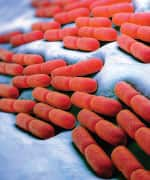Life Extension Magazine®
Your oral cavity is teeming with over 700 different species of bacteria.
It is second only to the gut for size and diversity of microbial communities in your body.1,2
An unbalanced oral microbiota may contribute to systemic disease conditions.2
Even with daily brushing and flossing, many people still end up with periodontal disease, often referred to as gum disease.
Researchers have identified a way to reduce gum disease and improve oral health that can provide additional protection beyond daily brushing. 3,4
Improving gum health may lower the risk for a host of inflammatory disorders commonly associated with aging.
Gum Disease Threatens the Whole Body
More than 47% of people over age 30 have gum disease. After age 65, the rate rises to a shocking 70%.5
Gum disease, or periodontal disease, is associated with disorders throughout the body, including cardiovascular, lung, kidney, bone, and Alzheimer’s diseases.
An underlying link is periodontal disease’s effect on the oral microbiota, the natural community of microbes living in the oral cavity.
When healthy, the oral microbiota supports and protects the delicate mucous membranes as well as the surface of the teeth themselves.
However, inadequate oral hygiene, as well as poor diet and lifestyle factors, drugs, and disease, can disrupt this balance. The resulting microbial imbalance—often called dysbiosis—allows excessive growth of pathogenic (disease-causing) organisms in the oral cavity.
This, in turn, disrupts the mouth’s immune system and creates a vicious cycle that can have disastrous effects on many body systems,6 causing diseases in parts of the body far removed from the mouth itself.7
Two Beneficial Bacteria Halt Gum Disease
Probiotics are beneficial live bacteria. They have been used for years to rebalance the gut microbiota, supporting the growth of helpful organisms and crowding out harmful ones.
The oral cavity holds the second largest and diverse microbiota after the gut.1
Beneficial bacteria reduce the dangerous strains, which allows a wider range and number of beneficial microbes to succeed.
After studying numerous types of bacteria, scientists identified two specific strains that can restore oral health and halt the process of periodontal disease:3,8,9
- Lactobacillus plantarum L-137, which boosts oral immune function and promotes healing, and
- Streptococcus salivarius M18, which kills harmful oral bacteria and then flourishes.
Beneficial Effects

Scientists conducted research into understanding how these two bacteria promote oral health.
They found that a heat-treated form of Lactobacillus plantarum L-137 could improve the immune system’s fighting ability.3
In a rat model of metabolic syndrome, oral treatment with L. plantarum L-137 was shown to have anti-inflammatory effects on cardiac and fat tissue. That resulted in reduced:10
- Heart dysfunction,
- Accumulation of fat mass under the skin,
- Insulin resistance (a cause of high blood sugar), and
- Levels of pro-inflammatory IL-6.
The probiotic Streptococcus salivarius M18 was shown to:
- Colonize the human mouth to generate healthy bacteria to compete with harmful bacteria,8,9
- Generate bacteria-suppressing weapons called bacteriocins, which function like antibiotics at the local level,11-13 to inhibit tooth and gum disease–producing organisms,8,12-14
- Produce the enzymes dextranase and urease, which break down dental plaque,8
- Promote a neutral oral pH, which supports the oral microbiota,8 and
- Reduce IL-6, lowering the inflammation that accelerates gum disease and threatens the body.8
Researchers then set out to validate these strains in clinical trials.
L. plantarum L-137 Fights Gum Disease
Scientists conducted a controlled, randomized trial of L. plantarum L-137 on 39 volunteers with chronic periodontitis.3
Some participants received a placebo. Others took a capsule containing heat-treated L. plantarum L-137.3
Researchers used a periodontal probe to measure the pocket depth, the distance from the gum line to the bottom of the tiny pocket between the gum and tooth root. Healthy gum pockets are 3 mm or less, while a depth of 4 mm or more is clinically defined as periodontal disease.15
After 12 weeks, those treated with L. plantarum had a 64% greater improvement in pocket depth than placebo recipients.3
These results demonstrate that periodontal disease can be improved with L. plantarum L-137.
S. Salivarius Improves Oral Health

Reducing pocket depth is just one piece of the perio-dontal disease puzzle, another is dental plaque.
One clinical trial showed that 88% of S. salivarius recipients maintained plaque scores lower than their pretreatment values after a three-month treatment period, compared with 44% of placebo recipients.8
Investigators then conducted a trial to test how S. salivarius M18 affected broader parameters of oral health.4
Scientists recruited men and women, aged 20-60, with moderate or severe gingivitis (inflammation of the gums) and moderate periodontitis.
For 30 days, half received no treatment, and half took lozenges containing 200 million bacteria of the S. salivarius M18 strain daily after brushing.4
On the last day of treatment, compared to the untreated group, those in the S. salivarius M18 group had:4
- 44% lower mean plaque index scores,
- 42% lower mean gingival index scores (which assess the prevalence and severity of gingivitis),
- 53% lower modified sulcus bleeding index scores (a measurement of gum bleeding), and
- 20% lower pocket depth measurements.
Treatment was then stopped, and measurements were taken 30 days later. Even then, a month after treatment had ended, the lozenge group had:4
- 37% lower mean plaque index scores,
- 35% lower mean gingival index scores,
- 51% lower modified sulcus bleeding index scores, and
- 22% lower probing pocket depth measurements.
This means that the probiotic lozenge significantly improved periodontal health—and sustained these benefits long after treatment stopped.
What you need to know
Beneficial Bacteria Promote Oral Health
- Gum disease is extremely common in older adults. It often leads to bleeding gums and tooth loss.
- Gum disease is associated with body-wide health problems, including cardiovascular disease, lung and kidney diseases, cancer, and others.
- Maintaining a healthy and balanced oral microbiota protects against gum disease.
- A heat-treated form of the probiotic strain L. plantarum L-137 boosts oral immune function, reducing inflammation and promoting healing.
- The probiotic strain S. salivarius M18 has been documented to rebalance the bacterial populations of the mouth, improving oral health.
- Taken daily, these two beneficial bacteria can help prevent gum disease, enhancing oral and total body health.
Summary

Gum disease affects more than 70% of older adults.
It often leads to tooth loss and is associated with an increased risk of serious disorders throughout the body.
A cofactor in the development of periodontal disease is an imbalance in the normal microbial community of the oral cavity.
Scientists have shown that a heat-treated form of the probiotic strain L. plantarum L-137 boosts oral immune function, reduces inflammation, and promotes healing.
A second probiotic strain, S. salivarius M18, rebalances the bacterial populations of the mouth, crowding out harmful microbes.
Studies show that these two beneficial bacteria strains help prevent gum disease and protect oral and total body health.
The ideal time to initiate oral probiotics is after a professional teeth cleaning.
If you have any questions on the scientific content of this article, please call a Life Extension® Wellness Specialist at 1-866-864-3027.
References
- Deo PN, Deshmukh R. Oral microbiome: Unveiling the fundamentals.Journal of oral and maxillofacial pathology : JOMFP. 2019 an-Apr;23(1):122-8.
- Gao L, Xu T, Huang G, et al. Oral microbiomes: more and more importance in oral cavity and whole body. Protein & cell. 2018;9(5):488-500.
- Iwasaki K, Maeda K, Hidaka K, et al. Daily Intake of Heat-killed Lactobacillus plantarum L-137 Decreases the Probing Depth in Patients Undergoing Supportive Periodontal Therapy. Oral Health Prev Dent. 2016;14(3):207-14.
- Scariya L, Nagarathna DV, Varghese M. Probiotics in Periodontal Therapy. Int J Pharm Bio. 2015 Jan;6(1):242-50.
- Available at: https://www.cdc.gov/oralhealth/conditions/periodontal-disease.html. Accessed December 4, 2020.
- Mawardi HH, Elbadawi LS, Sonis ST. Current understanding of the relationship between periodontal and systemic diseases. Saudi Med J. 2015 Feb;36(2):150-8.
- Bizzini B, Pizzo G, Scapagnini G, et al. Probiotics and oral health. Curr Pharm Des. 2012;18(34):5522-31.
- Burton JP, Drummond BK, Chilcott CN, et al. Influence of the probiotic Streptococcus salivarius strain M18 on indices of dental health in children: a randomized double-blind, placebo-controlled trial. J Med Microbiol. 2013 Jun;62(Pt 6):875-84.
- Burton JP, Wescombe PA, Macklaim JM, et al. Persistence of the oral probiotic Streptococcus salivarius M18 is dose dependent and megaplasmid transfer can augment their bacteriocin production and adhesion characteristics. PLoS One. 2013;8(6):e65991.
- Uchinaka A, Azuma N, Mizumoto H, et al. Anti-inflammatory effects of heat-killed Lactobacillus plantarum L-137 on cardiac and adipose tissue in rats with metabolic syndrome. Sci Rep. 2018 May 25;8(1):8156.
- Islam MR, Nagao J, Zendo T, et al. Antimicrobial mechanism of lantibiotics. Biochem Soc Trans. 2012 Dec 1;40(6):1528-33.
- Bierbaum G, Sahl HG. Lantibiotics: mode of action, biosynthesis and bioengineering. Curr Pharm Biotechnol. 2009 Jan;10(1):2-18.
- Wescombe PA, Upton M, Renault P, et al. Salivaricin 9, a new lantibiotic produced by Streptococcus salivarius. Microbiology. 2011 May;157(Pt 5):1290-9.
- Wescombe PA, Upton M, Dierksen KP, et al. Production of the lantibiotic salivaricin A and its variants by oral streptococci and use of a specific induction assay to detect their presence in human saliva. Appl Environ Microbiol. 2006 Feb;72(2):1459-66.
- Available at: http://www.merckmanuals.com/professional/dental-disorders/periodontal-disorders/periodontitis. Accessed February 1, 2017.

